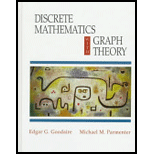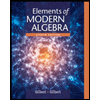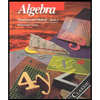
Let
(a) not reflexive, not symmetric, and not transitive.
(b) reflexive, but neither symmetric nor transitive.
(c) symmetric, but neither reflexive nor transitive.
(d) transitive, but neither reflexive nor symmetric.
(e) reflexive and symmetric, but not transitive.
(f) reflexive and transitive, but not symmetric.
(g) symmetric and transitive, but not reflexive.
(h) reflexive, symmetric, and transitive.
Want to see the full answer?
Check out a sample textbook solution
Chapter 2 Solutions
Discrete Mathematics with Graph Theory (Classic Version) (3rd Edition) (Pearson Modern Classics for Advanced Mathematics Series)
Additional Math Textbook Solutions
Finite Mathematics & Its Applications (12th Edition)
Fundamentals of Differential Equations and Boundary Value Problems
Using & Understanding Mathematics: A Quantitative Reasoning Approach (7th Edition)
Pathways To Math Literacy (looseleaf)
Differential Equations: An Introduction to Modern Methods and Applications
Mathematics for Elementary Teachers with Activities (5th Edition)
- Give an example of a relation R on a nonempty set A that is symmetric and transitive, but not reflexive.arrow_forwardDoes the relation is a brother of have a reflexive property consider one male? A symmetric property consider two males? A transitive property consider three males?arrow_forwardIn each of the following parts, a relation is defined on the set of all human beings. Determine whether the relation is reflective, symmetric, or transitive. Justify your answers. xRy if and only if x lives within 400 miles of y. xRy if and only if x is the father of y. xRy if and only if x is a first cousin of y. xRy if and only if x and y were born in the same year. xRy if and only if x and y have the same mother. xRy if and only if x and y have the same hair colour.arrow_forward
 Elements Of Modern AlgebraAlgebraISBN:9781285463230Author:Gilbert, Linda, JimmiePublisher:Cengage Learning,
Elements Of Modern AlgebraAlgebraISBN:9781285463230Author:Gilbert, Linda, JimmiePublisher:Cengage Learning, Elementary Geometry For College Students, 7eGeometryISBN:9781337614085Author:Alexander, Daniel C.; Koeberlein, Geralyn M.Publisher:Cengage,
Elementary Geometry For College Students, 7eGeometryISBN:9781337614085Author:Alexander, Daniel C.; Koeberlein, Geralyn M.Publisher:Cengage, Algebra: Structure And Method, Book 1AlgebraISBN:9780395977224Author:Richard G. Brown, Mary P. Dolciani, Robert H. Sorgenfrey, William L. ColePublisher:McDougal Littell
Algebra: Structure And Method, Book 1AlgebraISBN:9780395977224Author:Richard G. Brown, Mary P. Dolciani, Robert H. Sorgenfrey, William L. ColePublisher:McDougal Littell


